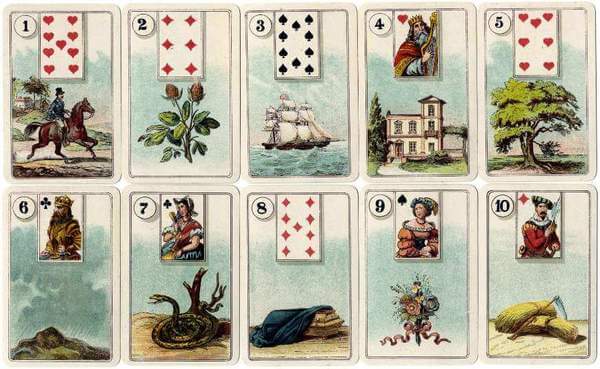People have been fascinated for centuries to catch a glimpse of the future and to know their fate. All possible means were used for this. In this way, numerous forms of forecasting have arisen over time. A crystal ball, runes, sticks, water, and tea leaves are some tangible objects that were used as an aid to reveal the tip of the deep secret. Cartomancy did not appear until later.
The laying of cards, also called Cartomancy (card laying art), is a part of divination. The very modern, at the end of the 18th Century came into fashion, using special or standardized playing cards (such as Lenormand, Gypsy, tipper and Tarot cards, or even an ordinary skate blade) in a conversation between fortune teller and customer or in to make a statement for yourself about situations, people and related issues. Completely independent of the suitability as a serious prognosis, which was already questioned in the 18th century, the technique is popular and widespread up to the present day.
In this blog post,we will discuss
- Fortune telling
- Cartomancy
- The emergence of cartomancy
- A game of the devil
- Different fortune telling cards
- The oracle of Marie-Anne Lenormand
Fortune telling

Another word for divination is divination or the art of divination. Dividing is one of the oldest human practices and has been used for at least three thousand years. It is true art because it is creative and uses images, shapes, signs, symbols, and patterns to reveal deep secrets. Yet divination does not always mean “predicting the future.” It can also be applied to gain insight into oneself, to face reality and to show how the law of cause and effect will work out.
Cartomancy
Each method of divination is different and over the centuries numerous forms of oracles have emerged that are consulted, to gain insight into the past, present, and future. An oracle that has many followers is undoubtedly cartomancy, which means predicting with cards. The origin of fortune-telling with the aid of cards is still a mystery, and since no one knows exactly who invented this method, various theories have emerged. One assumes that the origin is in Egypt while another theory says that they are from China. There is, however, a strong suspicion that gypsies invented this method of fortune-telling because these people mastered this art very well.
The emergence of cartomancy
Nowadays everyone knows a game with dice, but throwing stones is also a very old method of divination. Before the standard cube became the norm, people used to use fruit kernels, shells, stones, etc. Dice were astragals and sheep’s legs for the Greeks and Romans. For the Africans, these were marked bones. Later the stones were described with letters and numbers, to be able to read the oracle of “the fallen stones”. In the late classical period, the street antics arose and according to ancient writings, playing cards gradually emerged “from the dice game”. These cards were mainly used for playing but later also for oracle. Over time, they were adapted step by step and provided with symbols so that each card expressed something specific. The tarot was born.
A game of the Devil
The fortune-telling using the map was mainly practiced by the traveling people and soon conquered the whole of Europe. The cards were divided into four colors and widely popular as a card game. Here too, the people quickly learned to say fortune using the cards. According to the church, however, this was a game of the devil and they forbade the card game and also divination. Despite the strict ban, the card game was still used daily. The knowledge was passed on from generation to generation, so that charting still exists today.
Different fortune telling cards
The card deck of the tarot consists of two parts, the Major Arcana, and the Minor Arcana. The Great Arcana contains twenty-two trump cards and have large format figures with name and number. These are the Gods and suggest the archetypal worlds. The Little Arcana counts fifty-six cards and includes four series of fourteen cards each: the chalices, rods, swords, and pentacles that correspond to the four elements, water, fire, air, and earth.
In the nineteenth century, the tarot was a very important source of inspiration for many card-makers, for the development of their card deck. In the present life, various fortune-telling cards are derived from the tarot: gypsy cards, Lenormand cards, Kipper cards, etc.
The oracle of Marie-Anne Lenormand

One of the best-known map makers in history is probably Marie-Anne Adelaide Lenormand. In her time, this lady predicted not only the fame and success of Napoleon but also his fall. Mlle Lenormand gave the playing cards a complete transformation. She gave the game clear and clear symbols and also developed new laying methods. All her knowledge of forecasting was never written down but passed on orally.
The first cards of Mlle Lenormand date from 1845. The Great Lenormand game with fifty-four cards appeared at Grimaud in France. The maps were developed entirely according to the insights of Mlle Lenormand and introduced by Madame Breteau, who at the time was a student of Mlle Lenormand. In 1850, The Dondorf company iced up the Kleine Lenormandspel containing thirty-six cards. Today they are used worldwide as a wise counselor. Each card has its character and contains a wealth of information so that they can give a clear answer to daily questions.
